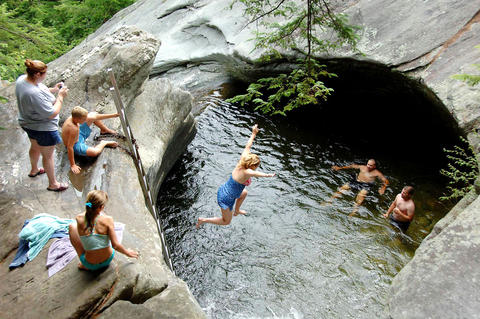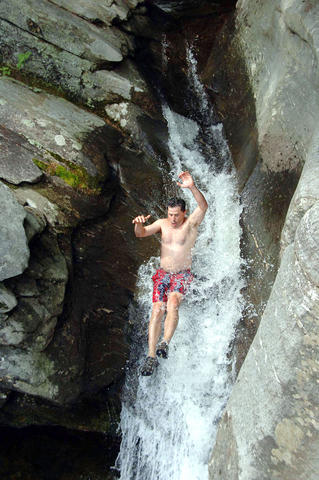On top of Danby Slide, a slick, 18m-long chute of the Mill River in Danby, Vermont, Samantha Gill eased down to sit in a rush of water. Her hands were splayed back. Elbows locked. A roar of current tugged at her toes.
"OK, here it goes," she said.
The river took hold, and Gill was descending, no stopping now. The ride skirted a rib of exposed stone, then bumped left, diving steep to a drop, plunging Gill 1m into a bubbling pool below.

PHOTO: NY TIMES NEWS SERVICE
She came up smiling, slicking her hair back.
"An old pro," said Dave Hajdasz, a fellow slider standing on the bank of the stream.
It was a Sunday afternoon, muggy and hot by Vermont standards, and Gill was out on an adventure. "I swim here and do these slides," she said, motioning upstream toward a gorge of falling water.

PHOTO: NY TIMES NEWS SERVICE
Natural water slides - essentially whitewater chutes navigable on your rear end - flank rivers and streams in places like Vermont, where tumbling water and time have worn smooth paths over stone. Rides like the Danby Slide, an unmarked locals' play spot just west from Route 7 in a gorge above its namesake town, provide a slippery fast slope, slicked with algae and smooth enough to be safe, allowing humans to slide like otters off a riverbank.
"You feel like a kid again doing this," said Hajdasz, a 45-year-old financial planner from Meriden, Connecticut. "I can do it all day long."
In late July, under a faultless blue sky, I joined Hajdasz to tour some water-slide sites around the state. As a contributor to www.swimmingholes.info, Hajdasz was in Vermont for the weekend, taking notes and photographs for the site. "I'm the regional correspondent," he said, dripping wet and smiling after a dip.
Natural water slides, found in most states, range from 3m-long child-friendly chutes to harrowing steep descents that launch sliders from the lip of a waterfall. Shallow water and slick stone are defining traits. Water levels dictate a slide's speed and seriousness; heavy rain or springtime flooding can create dangerous conditions.
New England, Vermont and New Hampshire boast dozens of slides in the White and Green Mountains, where old hills with bedrock-bottom creeks can create perfect sliding. Maine can claim at least eight slide sites, including the mellow Ledges Slide at Baxter State Park in the northern part of the state, and the more precipitous Cataracts Falls, a 9m plunge near Andover in western Maine.
Pennsylvania's Ohiopyle State Park, southeast of Pittsburgh, has two slides on the Youghiogheny River. "Sit in the creek bed and ride the water," the park's Web site advises. An observation deck overlooks a 9m-long flume.
Outside the US, sliders zip with river currents off drops from Nigeria to Fiji. Samoa, Australia, Israel, Nigeria, New Zealand and Belize have highlighted slides on www.naturalwaterslides.com, a site that catalogs water slides around the globe.
Most water slides are do-it-yourself adventures, often a side activity to a day swimming in a creek. Whitewater rafters might slide a stream as an ancillary activity. Slide locations are rarely marked, and only a handful of guide companies lead trips to water slides.
Robert Netzer, a 34-year-old engineering manager from Bloomington, Minnesota, had never heard of a natural water slide before traveling to New Zealand last winter. "Our guide held us over the falls by our ankles, then let go," he said, describing a head-first plunge canyoneering near Queenstown.
The New Zealand guide company, XII Mile Delta Canyoning (www.xiimile.co.nz), incorporates multiple water slides into its daylong river-exploration trips. "That plunge was a highlight of the day," Netzer said.
On the New Haven River in Vermont, a clear stream coming out of the Green Mountains near Bristol, I took my virgin plunge in a narrow chute above a pool. It was 11am, and two other sliders were frolicking upstream. The water was cold and utterly clear. The slide, a slot running horizontal to the river's main flow, tugged on my feet as I sat down. "Lean back," someone yelled.
I held my breath and straightened my arms. The water took hold, and I was free, a fish rocketing downriver, skipping off smooth stone, then dropping into a pool.
Circle Current, the local name for this whitewater stretch of the New Haven River, includes several narrow slides through its protruding bedrock slabs, one 12m long.
Elisa Adams, a 48-year-old chiropractor from Concord, Massachusetts, hesitated atop the lower slide. "Water's cold," she said.
But she slid anyway, shooting underwater on her back, disappearing under the froth, then re-emerging to plunk into the pool below.
Her daughter, Ariana, 18, was up next. "I've seen these slides before but have never done it," she said a moment before sliding off.
At Danby Slide, our next stop, a half-dozen swimmers were upstream of the main chute, warming up on a little slide. Hajdasz dipped a foot in the mountain water. "About 16°C," he said.
Always eager to swim, Hajdasz went first. "Whoo-hoo," he yelled on the way by.
Gill, a student from nearby Bennington College, slid second.
Soon, a line was forming at the top of Danby Slide. Its 18m length, combined with an algae-slick surface and a launching into a pool below, make the slide one of the best in the state.
I rode it three times, sitting bolt upright, letting my body literally go with the flow. The ride accelerates as it goes down, getting steeper. Then it launches from a lip over a cascade into deep water.
Miaya and Marissa Trombino - sisters, eight and nine, respectively - came down with a scream. Miaya piggybacked Marissa, both plugging their noses midair before the splash. They dog-paddled to the pool's edge.
"That was fun," said Marissa.
"That was so fun," mimicked Miaya.
A man barreled down Danby Slide on an inner tube. Three people slid past as a train.
"Busy day," said Hajdasz, tromping up to slide again. "I want one more ride."

The canonical shot of an East Asian city is a night skyline studded with towering apartment and office buildings, bright with neon and plastic signage, a landscape of energy and modernity. Another classic image is the same city seen from above, in which identical apartment towers march across the city, spilling out over nearby geography, like stylized soldiers colonizing new territory in a board game. Densely populated dynamic conurbations of money, technological innovation and convenience, it is hard to see the cities of East Asia as what they truly are: necropolises. Why is this? The East Asian development model, with

June 16 to June 22 The following flyer appeared on the streets of Hsinchu on June 12, 1895: “Taipei has already fallen to the Japanese barbarians, who have brought great misery to our land and people. We heard that the Japanese occupiers will tax our gardens, our houses, our bodies, and even our chickens, dogs, cows and pigs. They wear their hair wild, carve their teeth, tattoo their foreheads, wear strange clothes and speak a strange language. How can we be ruled by such people?” Posted by civilian militia leader Wu Tang-hsing (吳湯興), it was a call to arms to retake

Desperate dads meet in car parks to exchange packets; exhausted parents slip it into their kids’ drinks; families wait months for prescriptions buy it “off label.” But is it worth the risk? “The first time I gave him a gummy, I thought, ‘Oh my God, have I killed him?’ He just passed out in front of the TV. That never happens.” Jen remembers giving her son, David, six, melatonin to help him sleep. She got them from a friend, a pediatrician who gave them to her own child. “It was sort of hilarious. She had half a tub of gummies,

The wide-screen spectacle of Formula One gets a gleaming, rip-roaring workout in Joseph Kosinski’s F1, a fine-tuned machine of a movie that, in its most riveting racing scenes, approaches a kind of high-speed splendor. Kosinski, who last endeavored to put moviegoers in the seat of a fighter jet in Top Gun: Maverick, has moved to the open cockpits of Formula One with much the same affection, if not outright need, for speed. A lot of the same team is back. Jerry Bruckheimer produces. Ehren Kruger, a co-writer on Maverick, takes sole credit here. Hans Zimmer, a co-composer previously, supplies the thumping